|
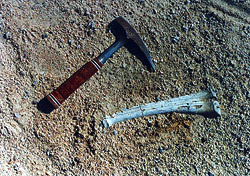 |
| Click on the image for a
larger view. Here is the camel metapodial (one of the foot bones)
as discovered weathering out of the Upper Pleistocene Manix Formation
near Bassett Point, San Bernardino County, California. The specimen
is likely between 40 and 19 thousand years old. For scale, the
geology hammer is 33 centimeters in length (slightly over a foot
long). |
|
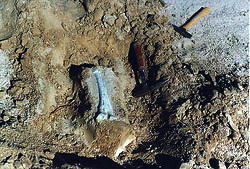 |
| Click on the image for a
larger view. Excavating a trench around the specimen to determine
the full extent of the find (who knows, perhaps there could have
been an entire skeleton associated with the metapodial?). In
retrospect, probably somewhat more matrix should have been left
around the sides of the specimen to help support it during removal
from its Pleistocene entombment. |
|
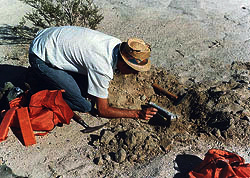 |
| Click on the image for a
larger view. Gently cleaning the specimen during the excavation.
Also, since the camel bone was neither petrified nor thoroughly
permineralized (replaced by silica, for example), a fast-drying
preserving agent was liberally applied to the surface. |
|
 |
| Click on the image for a
larger view. At this point, the late Pleistocene camel bone is
almost ready to be gently pried loose--along with the pedestal
atop which it rests-- from its loosely consolidated sand and
silt matrix. |
|
|
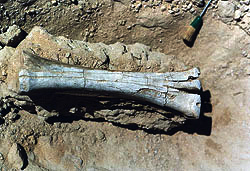
|
| Click on the image for a
larger view. Finally, the camel metapodial has been lifted from
its Pleistocene resting ground, to the side of the trench, where
additional preserving agents will be liberally applied to the
surface, to help stabilize the fragile fossil specimen. |
|
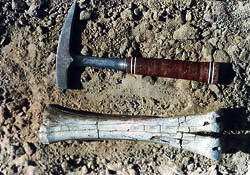
|
| Click on the image for a
larger view. Here is a top-view perspective of the camel bone
from the Upper Pleistocene Manix Formation. The geology hammer
is 33 centimeters long, or slightly over a foot in length. Now
the bone is ready for transportation to a more secure spot nearby,
where a plaster of paris jacket will be applied to its surface.
Probably the plastering process should have been done just as
we pried the pedastal loose, before moving the entire block. |
|
|
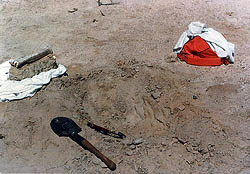
|
| Click on the image for a
larger view. Here is the aftermath of the fossil dig: a "fossil
crater" left behind in the Upper Pleistocene Manix Formation--a
hole later refilled and smoothed over. The camel metapodial,
resting atop its pedestal, now awaits a final covering with a
plaster of paris jacket, helping to ensure its safe transport
back to civilization. |
|









